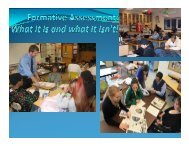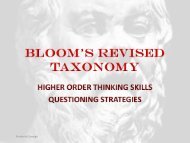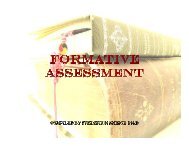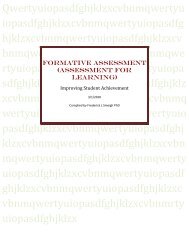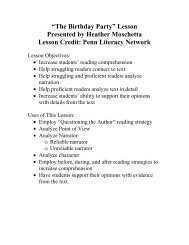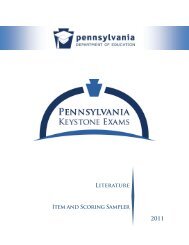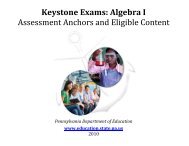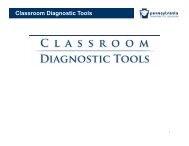PSSA Accommodations Guidelines for Students with IEPs and
PSSA Accommodations Guidelines for Students with IEPs and
PSSA Accommodations Guidelines for Students with IEPs and
You also want an ePaper? Increase the reach of your titles
YUMPU automatically turns print PDFs into web optimized ePapers that Google loves.
St<strong>and</strong>ard<br />
Ethics/<br />
Security<br />
Invalidates<br />
score<br />
Pennsylvania Department of Education<br />
<strong>Accommodations</strong> <strong>Guidelines</strong> <strong>for</strong> <strong>Students</strong> <strong>with</strong> <strong>IEPs</strong> <strong>and</strong> <strong>Students</strong> <strong>with</strong> 504 Plans<br />
TABLE 3: SETTING ACCOMMODATIONS<br />
DESCRIPTION OF SETTING ACCOMMODATIONS<br />
Not allowable<br />
<strong>for</strong> <strong>PSSA</strong>,<br />
<strong>PSSA</strong>-M &<br />
Keystone<br />
(paper/pencil)<br />
Reduce Distractions to the Student<br />
A setting accommodation to reduce distractions would allow a student to do<br />
individual work or take tests in a different location, usually in a place <strong>with</strong> few or no<br />
other students. Changes may also be made to a student’s location <strong>with</strong>in a room.<br />
For example, a student who is easily distracted may not want to sit near windows,<br />
doors, or pencil sharpeners.<br />
Sitting near the teacher’s desk or in the front of a classroom may be helpful <strong>for</strong><br />
some students.<br />
Physically enclosed classrooms (classrooms <strong>with</strong> four walls) may be more<br />
appropriate than open classrooms,<br />
Study carrels might be helpful <strong>for</strong> students who are easily distracted.<br />
<strong>Students</strong> <strong>with</strong> low vision may prefer to sit in the part of a room that has the best<br />
light.<br />
Some students concentrate best while wearing noise buffers such as earphones,<br />
earplugs, or headphones.<br />
Reduce Distractions to Other <strong>Students</strong><br />
Some students use accommodations that may distract other students.<br />
For example, some students need a reader or scribe.<br />
In addition, some students might per<strong>for</strong>m better when they can read <strong>and</strong> think out<br />
loud or make noises that distract other students.<br />
Distractions to other students are reduced by using these accommodations in<br />
individual settings.<br />
Small Group<br />
A small group setting allows a student to take the test in a different location usually in<br />
a place <strong>with</strong> few or no other students.<br />
No more than 5 in a group <strong>for</strong> students who need the entire test read aloud.<br />
Approximately 8-12 in a group is typical <strong>for</strong> reasons such as distractibility <strong>and</strong><br />
partial read alouds.<br />
The Keystone Exams will not be administered 2011-2012 44 1/24/2012



